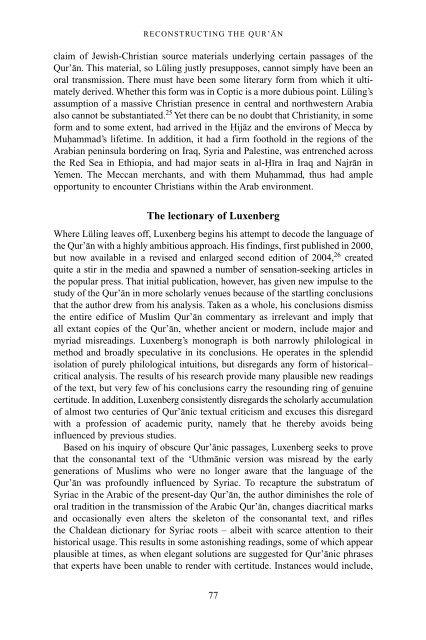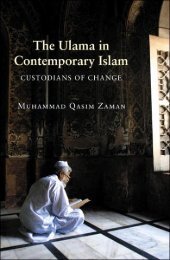The Qur'an in its historical context (pdf - Islam and Christian-Muslim ...
The Qur'an in its historical context (pdf - Islam and Christian-Muslim ...
The Qur'an in its historical context (pdf - Islam and Christian-Muslim ...
You also want an ePaper? Increase the reach of your titles
YUMPU automatically turns print PDFs into web optimized ePapers that Google loves.
RECONSTRUCTING THE QUR’AN<br />
claim of Jewish-<strong>Christian</strong> source materials underly<strong>in</strong>g certa<strong>in</strong> passages of the<br />
Qur’an. This material, so Lül<strong>in</strong>g justly presupposes, cannot simply have been an<br />
oral transmission. <strong>The</strong>re must have been some literary form from which it ultimately<br />
derived. Whether this form was <strong>in</strong> Coptic is a more dubious po<strong>in</strong>t. Lül<strong>in</strong>g’s<br />
assumption of a massive <strong>Christian</strong> presence <strong>in</strong> central <strong>and</strong> northwestern Arabia<br />
also cannot be substantiated. 25 Yet there can be no doubt that <strong>Christian</strong>ity, <strong>in</strong> some<br />
form <strong>and</strong> to some extent, had arrived <strong>in</strong> the Hijaz <strong>and</strong> the environs of Mecca by<br />
Muhammad’s lifetime. In addition, it had a firm foothold <strong>in</strong> the regions of the<br />
Arabian pen<strong>in</strong>sula border<strong>in</strong>g on Iraq, Syria <strong>and</strong> Palest<strong>in</strong>e, was entrenched across<br />
the Red Sea <strong>in</strong> Ethiopia, <strong>and</strong> had major seats <strong>in</strong> al-Hira <strong>in</strong> Iraq <strong>and</strong> Najran <strong>in</strong><br />
Yemen. <strong>The</strong> Meccan merchants, <strong>and</strong> with them Muhammad, thus had ample<br />
opportunity to encounter <strong>Christian</strong>s with<strong>in</strong> the Arab environment.<br />
<strong>The</strong> lectionary of Luxenberg<br />
Where Lül<strong>in</strong>g leaves off, Luxenberg beg<strong>in</strong>s his attempt to decode the language of<br />
the Qur’an with a highly ambitious approach. His f<strong>in</strong>d<strong>in</strong>gs, first published <strong>in</strong> 2000,<br />
but now available <strong>in</strong> a revised <strong>and</strong> enlarged second edition of 2004, 26 created<br />
quite a stir <strong>in</strong> the media <strong>and</strong> spawned a number of sensation-seek<strong>in</strong>g articles <strong>in</strong><br />
the popular press. That <strong>in</strong>itial publication, however, has given new impulse to the<br />
study of the Qur’an <strong>in</strong> more scholarly venues because of the startl<strong>in</strong>g conclusions<br />
that the author drew from his analysis. Taken as a whole, his conclusions dismiss<br />
the entire edifice of <strong>Muslim</strong> Qur’an commentary as irrelevant <strong>and</strong> imply that<br />
all extant copies of the Qur’an, whether ancient or modern, <strong>in</strong>clude major <strong>and</strong><br />
myriad misread<strong>in</strong>gs. Luxenberg’s monograph is both narrowly philological <strong>in</strong><br />
method <strong>and</strong> broadly speculative <strong>in</strong> <strong>its</strong> conclusions. He operates <strong>in</strong> the splendid<br />
isolation of purely philological <strong>in</strong>tuitions, but disregards any form of <strong>historical</strong>–<br />
critical analysis. <strong>The</strong> results of his research provide many plausible new read<strong>in</strong>gs<br />
of the text, but very few of his conclusions carry the resound<strong>in</strong>g r<strong>in</strong>g of genu<strong>in</strong>e<br />
certitude. In addition, Luxenberg consistently disregards the scholarly accumulation<br />
of almost two centuries of Qur’anic textual criticism <strong>and</strong> excuses this disregard<br />
with a profession of academic purity, namely that he thereby avoids be<strong>in</strong>g<br />
<strong>in</strong>fluenced by previous studies.<br />
Based on his <strong>in</strong>quiry of obscure Qur’anic passages, Luxenberg seeks to prove<br />
that the consonantal text of the ‘Uthmanic version was misread by the early<br />
generations of <strong>Muslim</strong>s who were no longer aware that the language of the<br />
Qur’an was profoundly <strong>in</strong>fluenced by Syriac. To recapture the substratum of<br />
Syriac <strong>in</strong> the Arabic of the present-day Qur’an, the author dim<strong>in</strong>ishes the role of<br />
oral tradition <strong>in</strong> the transmission of the Arabic Qur’an, changes diacritical marks<br />
<strong>and</strong> occasionally even alters the skeleton of the consonantal text, <strong>and</strong> rifles<br />
the Chaldean dictionary for Syriac roots – albeit with scarce attention to their<br />
<strong>historical</strong> usage. This results <strong>in</strong> some astonish<strong>in</strong>g read<strong>in</strong>gs, some of which appear<br />
plausible at times, as when elegant solutions are suggested for Qur’anic phrases<br />
that experts have been unable to render with certitude. Instances would <strong>in</strong>clude,<br />
77



